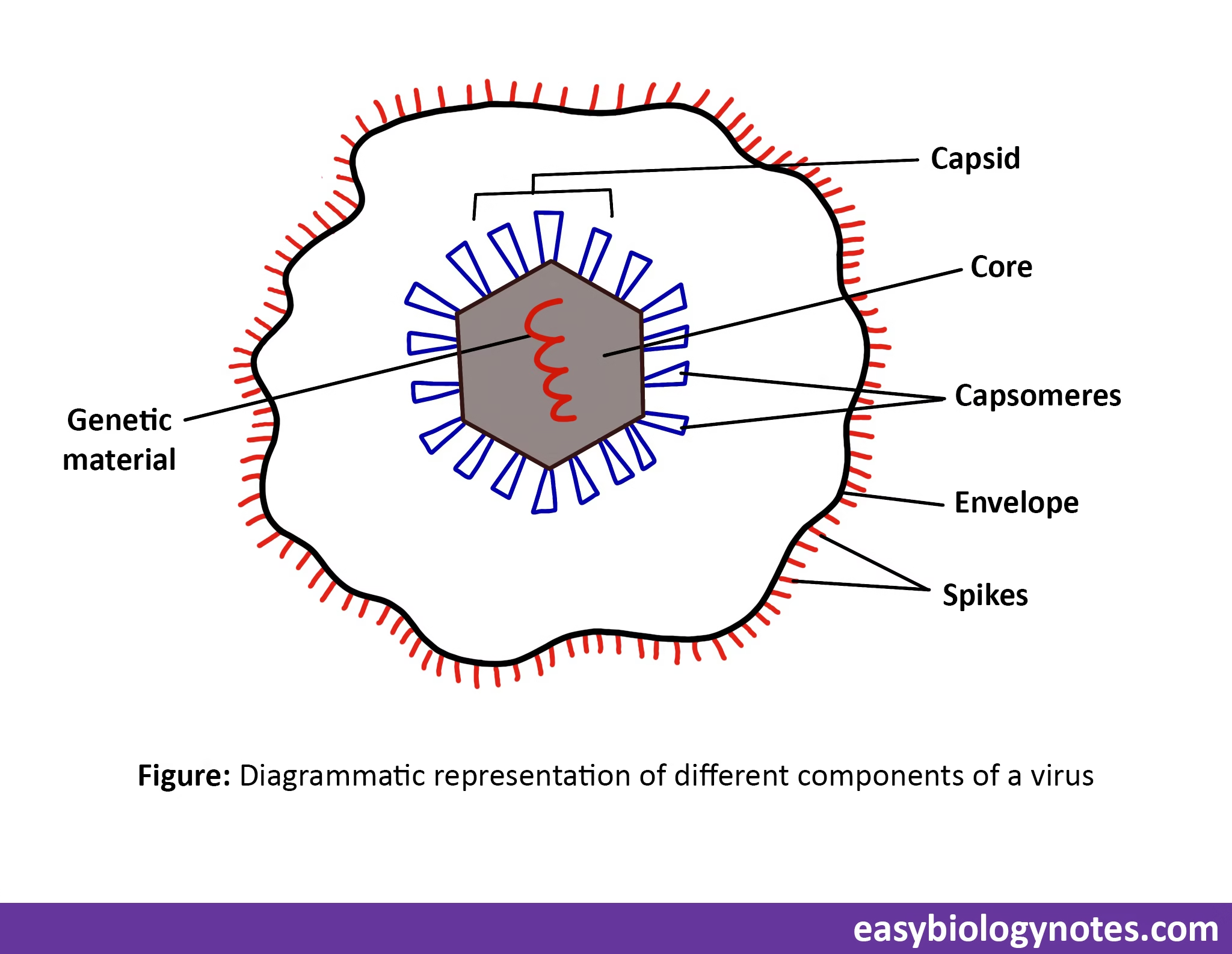What are Viruses?
- Viruses are intracellular obligate parasites, non-cellular (acellular) sub-microscopic organisms.
- The word “virus” means venom or poisonous fluid.
- They lack cell organelles and make use of the protein synthetic machinery of the host cell.
- Zwoff defined viruses as the infectious, potentially pathogenic nucleoproteins with only one type of nucleic acid, which reproduces from their genetic material and are unable to grow and divide outside the host’s cell.
Historical background of Viruses
- In 1886, A. Mayer observed a molting disease in leaves of tobacco plants and named it mosaic.
- In 1892, Dmitri Ivanowski was the first to discover a viral disease in plants.
- In 1898, M. W. Beijerinck put a concept of Contagium vivum fluidum (i.e., contagious living fluid), which was a phrase first used to describe a virus.
- The term virus was introduced by Louis Pasteur.
- In 1935, W. M. Stanley crystallized Tobacco Mosaic Virus (TMV was the first virus to be crystallized).
General characteristics of Viruses
- They are non-living outside the host’s cell but become living when they use host machinery for the synthesis of their protein.
- They can be cultured in living cultured media only.
- They replicate and do not grow, but their nucleic acid directs the host cell to make various parts of the virus and then to assemble these parts into complete infectious particles called virions.
Viruses as non-living
i. They can be crystallized.
ii. There is no cell wall membrane or cytoplasm.
iii. There are no cell organelles and they have no metabolism.
iv. They do not have functional autonomy.
Viruses as living entities
i. They have genetic material.
ii. They can mutate.
iii. They can be transmitted from one host to another.
iv. They are capable of multiplication within a host.
v. They are culturable on living tissues.
* Unique characters of viruses
- Presence of only DNA or RNA.
- Capacity to produce from single nucleic acid.
- They do not show cell division.
- They use the metabolic machinery of host cells to replicate.
Morphology of Viruses
[I] Shape
- Viruses are of different shapes such as spherical or cuboid (adenoviruses), elongated (TMV), coiled, bullet-shaped (rabies virus), filamentous, or tadpole-like (bacteriophages).
[II] Size
- They are of variable sizes from 10 nm–400 nm.
- Their size is determined by ultracentrifugation and electron microscopy (TEM – Transmission Electron Microscopy).
- They are smaller than bacteria.
[III] Structure
- Viruses are acellular, having no nucleus, cytoplasm, or cell membrane.
- The complete assembly of the infectious particle is known as virion.
- In each particle, there is a central core of nucleic acid surrounded by a protein coat called the capsid.
- The capsid is made up of many identical structural units called capsomeres.
- The composition, number, and form of capsomeres vary with kinds of viruses.
- The core with its capsid is known as nucleocapsid.
- Nucleocapsid may be naked or enveloped by a loose covering known as an envelope, and such viruses are known as Lipoviruses (mammalian viruses).
- There are certain projections of glycoproteins on envelope known as spikes arranged into distinct units.

Classification of Viruses
- Modern system of classification of viruses was proposed by Lwoff, Horne and Tournier, which is accepted by International Committee on Nomenclature of Viruses (ICNV) (later renamed as International Committee on Taxonomy of Viruses (ICTV) in 1977).
- Their classification is based upon the following characters:
- Type of nucleic acid
- Molecular weight of virus
- Shape and size of virus
- Symmetry of virus
- Presence or absence of envelope
- Number of capsomeres
Classification
[I] On the basis of nucleic acid
- ssRNA viruses (e.g., TMV, Poliovirus, Rabies virus, Influenza virus, Mumps virus, Measles virus, Retroviruses (e.g., HIV))
- dsRNA viruses (e.g., Reovirus, Rice dwarf virus)
- ssDNA viruses (e.g., Parvoviruses)
- dsDNA viruses (e.g., Poxvirus, Adenovirus, Herpes viruses, Papova viruses)
[II] On the basis of their host
- Plant viruses (Phytophaginae) → Plants
- Animal viruses (Zoophaginae) → Animals
- Bacteriophages (Phaginae) → Bacteria
- Cyanophages → Cyanobacteria
- Mycoviruses → Fungi
- Mycoplasmaviruses → PPLO
- Phycoviruses → Algae
* Plant and Animal Viruses
(a) Plant viruses
- Most of the plant viruses contain RNA as genetic material.
- All plant viruses lack an envelope.
Examples:
- ssRNA → TMV (Tobacco Mosaic Virus)
- dsRNA → Wound Tumor Virus (Reoviridae)
- dsDNA → Cauliflower Mosaic Virus
- ssDNA → Geminiviruses
(b) Animal viruses
- Animal viruses have both RNA and DNA as genetic material.
- They may or may not have envelopes.
Examples:
- ssRNA → Rhabdoviruses (e.g., Mumps virus, Measles virus), Retroviruses (e.g., HIV)
- dsRNA → Reovirus
- dsDNA → Papovaviruses, Adenoviruses, Herpes viruses
- ssDNA → Parvoviruses
[III] On the basis of their symmetry
a) Helical symmetry
- These are elongated, rod-shaped, rigid or flexible.
- Capsomeres are arranged in a helical or spiral manner.
- For example: TMV, Influenza virus
b) Cubical symmetry
- Viruses are more or less spherical in shape
- Example: Adenovirus, Polyomavirus
c) Complex symmetry
- They have combined features of cubic and helical symmetry viruses.
- They have unidentifiable capsids or have capsids with additional structures.
- Example: Bacteriophages, Vaccinia virus